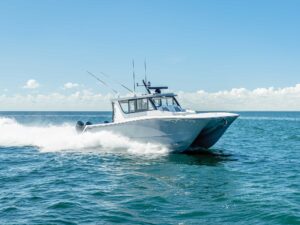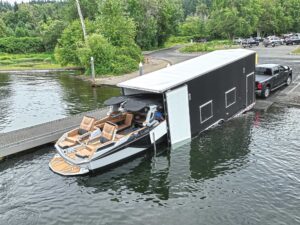Sand is flying everywhere. Our Hummer H2 SUT rocks and rolls, careening as if on ice before the four-wheel drive catches and powers the mighty truck through sugary powder and onward down the beach. There’s only one word to describe the sensation of blasting through terrain where normal cars go to die-YEE-HAAW!
What else would you scream in Texas while racing along the Padre Island National Seashore, a 60-mile stretch of wild beach that you can only access with a four-by-four? Yep, we’re at it again, on a mission to show you the endless possibilities available to boaters. In this case, we’re out to prove that you can take a boat anywhere you want, without resorting to that certain activity that most boaters would rather not do. To hell with the ball hitch!
Of course, a trailer wouldn’t last two minutes here in the loose sand beyond the tide line. That’s where the Hummer comes in. My fellow rambler-let’s call him Cowboy Dave-and I are hoping to access boating territory unavailable to mere rear-wheelers and take advantage of a large run of speckled trout chasing mullet through the surf.
Our boat? It’s just fine, thank you, tucked safely under a locked cover in this sport utility truck’s (SUT) small 35″-by-47″ pickup-style bed. In it we’ve packed a Zodiac Futura Mark 2C FR and a 9.8-hp Tohatsu outboard. When we reach the ideal spot to launch, we’ll back the Hummer to the waterline, pull out our boat-in-a-bag, inflate it, put the Tohatsu on the transom, and head out to sea. No shorted-out brake lights, no rusty leaf springs, no tricky turns, no worries. We’re heading out on the highway, looking for adventure, with nothing behind us.
Four on the Floor
Padre Island is just south and east of Corpus Christi. After passing through miles of soul-deadening industrial complexes and commercial strips, Route 22 South abruptly turns into a narrow two-laner surrounded by undeveloped, pristine dunes. No condominiums, no beach bungalows, nothing. Just a long untamed strip of land between the Gulf of Mexico and the Laguna Madre, the bay separating us from the mainland. The first five miles are accessible to anyone-we pass a Hyundai, for God’s sake-but after that, it’s strictly four-wheel country.
“Put the pedal to the metal, Tex,” Dave instructs, as we pass a “4 Wheel Drive Only” warning sign at the five-mile mark. I happily oblige, pressing the button that locks in the front wheels so we can maintain our 30-mph speed as the hard-packed sand turns softer by the second. The Hummer flawlessly handles the shifting terrain. It was literally made for this. We’re not any less comfortable than we were on Route 22, still grooving to the songs blasting from the XM Satellite Radio-some lowdown dirty country music about a truck-which two city boys now easily relate to.
The intense Texas heat breaks a little with some help from the sea breeze. We roll down the windows and open the sun roof for a cross wind, and suddenly life is good. The music, the beach, and the chance to go boating.
We run about 15 miles before we have the first opportunity to test the Hummer. Yarborough Pass, a steep, curving cut through the dunes, is the first transverse from the Gulf to the Laguna Madre. This is a world-renowned spot for redfish and speckled trout fishing, bird watching, and generally getting skinny in a boat.
The Pass would be easy to rumble by and miss, barely wide enough for a car to slip through. It’s not marked and we drive by it twice before we find it. Finally, Dave sees a brief interruption in the grassy dunes and spots what he thinks is it, a winding uphill climb through drifting sand. I ask him to step out and test the terra firma. He immediately sinks to his ankles. “Nothing firma ’round these parts,” he assures me.
Not one to get held back by a little sand, Dave yells out, “Let’s get deep into the heart of Texas, son” (or something equally cheesy). We line up the Hummer with the Pass and switch the beast into 4-Low. The 325-hp engine, with its massive 365 ft-lbs. of pulling torque, rumbles like a bull bursting at the gate, and we’re set to ride it through. I stomp the pedal and we vault forward, building up a head of steam. Sand flies all over the place as we slip and slide and bound through the narrow pass. The H2 gets its footing and forges ahead, and we emerge from the chute as proud as champion bull riders as we catch the first glimpse of the vast bay.
The Laguna Madre is teaming with life. I haven’t set foot off the running board when I notice that the water’s mirror-flat surface is bubbling like seltzer. Baitfish pop everywhere, with herons wading after them. “When you’re looking at water that’s knee high to a bird,” I say to Dave, “it’s probably not a good idea to launch there.” Dave tips his cowboy hat in agreement, grinning in the knowledge that we’d have to hammer the Hummer back through the pass, and this time it would be his turn to drive.
Everything’s Bigger
The miles keep ticking off as we drive “down island” along the Gulf. What other state would have so much undisturbed beachfront? Only this one. And what other state would let you explore every single mile of it in a big, bad, four-wheel vehicle? If someone told me that owning at least one large truck was a Texas state law, I wouldn’t question it for a minute.
They do other things big in Texas, too, like gamefish. The speckled trout down here grow large and mean-gator trout. We keep cruising down the beach looking for a spot to pull over and wrangle with some.
At Mile 23, I see what appears to be a school of mullet busting along the beach and decide this is a good place to launch. We run the Hummer right up to the wet part of the beach, open the tailgate, and drag the Zodiac onto the sand. I get the pump going and within 10 minutes, we have a boat. Dave mounts the little Tohatsu kicker, and together we pull the inflatable into the surf. Before you know it, I’m fishing soft plastics just beyond the surf line. I cast along a fast-moving school of mullet and quickly understand why they’re in such a hurry. My line comes taut and my rod doubles over. I’ve made an intimate connection with a genuine Texas gator trout. Tonight, there’ll be dinner for two.
The sun begins to set and the wind kicks up, blowing sand into places you’d rather it wouldn’t. I deflate the Zodiac, Dave takes care of the engine, and we haul both back into the Hummer, ready to find a protected place to pitch camp. We find a small recess in the dunes that keeps us sheltered from the worst of the wind and, more important, out of the tracks of passing four-wheel vehicles. There’s plenty of driftwood to build a fire. All we need now are some wind-proof matches. Uh-oh.
The necessities that we did remember to bring are a tent, a 94-quart cooler with food, and several gallons of freshwater-for drinking and getting the salt/sand coating off our bodies. We also packed a 12VDC air compressor. In deep sand it’s best to reduce tire pressure to improve grip, which means you need a way to reinflate the tires once back on pavement. The pump also helps with the boat.
Something we wish we had, other than the matches, is a 12-volt portable vacuum to suck up the sand. It’s in everything, embedded in my ears and hair, clinging to the Zodiac, piling in the floor of the Hummer. There’s no escaping it.
But hunger overcomes discomfort, and with a flash of ingenuity, I say to Dave, “I have a way to get that fire started,” while glancing at the Tohatsu. He spots my line of vision and smiles, knowing we have the ultimate primer-a quick shot of unleaded. Soon dinner, with a subtle tang of 87 octane, is served.
Hey Jim
You asked us if there was a way to go boating without a trailer and here’s your answer: “Ride ’em cowboy.”
With the right four-wheel-drive vehicle and an inflatable, you can put in just about anywhere. Besides Texas, parts of Florida, notably Daytona Beach, are just begging to be explored. If you’re in the Northwest, try the Long Beach Peninsula in Washington, which has 28 miles of drivable shoreline. Northern California has some open areas. Back East there’s the Cape Lookout National Seashore in Harkers Island, North Carolina, and long stretches of the south shore of Long Island, New York. And almost all lakes have dirt roads leading down to them. There are plenty of places around the country if you’re willing to look.
So forget about surge brakes and figuring out tongue weight and where to place your hands on the wheel. If you have recurring nightmares about getting stuck on a launch ramp doing endless 50-point turns while other boaters throw things at you, eliminate the problem. No trailer? No problem.
Behold, the Land Hatteras
There’s a subculture of fishermen who not only don’t like to trailer, but eschew the idea of boats altogether: mobile surfcasters. They do all their fishing from the beach, and they rig their trucks with enough angling equipment and amenities to rival an offshore battlewagon. Deep down, they’d rather be on the water, where the fish are, which is why a fully decked-out beach cruiser is known as a Land Hatteras.
We can’t see why anyone would want to sit on the beach when all the action is beyond the breakers. But for those of you who are thinking of giving it a try, here are some of the things you’ll need to turn your pickup into a sportfisherman.
- Most beach anglers drop in a Lance Camper (www.lancecamcamper.com). Prices from $10,000 to $30,000.
- Dual batteries let you run all your extras without burning out the alternator so that you’re able to get home.
- Power take-off air compressor. If you must, opt for a weaker12VDC version.
- The widest possible tires that will fit on your rims.
- The lowest axle ratio available for your model.
- Skid plates to keep rocks, beach debris, salt, and sand off the chassis.
- Fiberglass fender flares, which don’t rust and are easier to rinse.
- Rhino Lining or any equivalent spray-on or drop-in liner to protect the truck’s bed.
- A winch mounted on the front with 3,500′ wire-cable capacity to pull you or others out of trouble.
- Low intensity fog lights. Bright lights spook fish when night fishing in the surf.
- Fender-mounted cooler rack with rodholders.
- 12VDC aerator to turn a cooler into a baitwell.
- Overhead rodrack installed inside truck bed cap.
- Horizontal rodracks on the outside.
- 12VDC coffeemaker-critical for staying awake.









